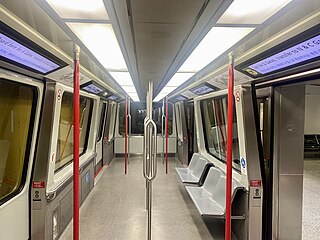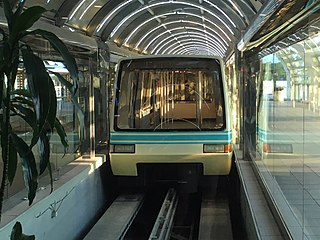
Kuala Lumpur International Airport (KLIA) is Malaysia's main international airport. It is located in the Sepang District of Selangor, approximately 45 kilometres (28 mi) south of Kuala Lumpur and serves the city's greater conurbation.

The ERL KLIA Ekspres is an express airport rail link servicing the Kuala Lumpur International Airport (KLIA) in Malaysia. It runs from KL Sentral, the main railway station of Kuala Lumpur to KLIA as well as its low-cost terminal, klia2. The line is one of the two services on the Express Rail Link (ERL) system, sharing the same tracks as the KLIA Transit. The KLIA Transit stops at all stations along the line, whereas the KLIA Ekspres runs as a direct non-stop express service between KL Sentral and KLIA/klia2. It is operated by Express Rail Link Sdn. Bhd. (ERL).

Sultan Abdul Aziz Shah Airport, , often called Subang Airport or Subang Skypark, is an airport located in Subang, Petaling District, Selangor, Malaysia.

The ERL KLIA Transit is a commuter rail service which serves as an airport rail link to the Kuala Lumpur International Airport (KLIA) in Malaysia. It runs from KL Sentral, the main railway station of Kuala Lumpur to KLIA Terminal 1 and KLIA Terminal 2. The line is one of the two services on the Express Rail Link (ERL) system, sharing the same tracks as the KLIA Ekspres. KLIA Transit stops at all stations along the line, whereas KLIA Ekspres runs an express, non-stop service between KL Sentral and the airport. The ERL is operated by Express Rail Link Sdn. Bhd. (ERL).

Rail transport in Singapore mainly consists of a passenger urban rail transit system spanning the entire city-state: a rapid transit system collectively known as the Mass Rapid Transit (MRT) system operated by the two biggest public transport operators SMRT Trains and SBS Transit, as well as several Light Rail Transit (LRT) rubber-tyred automated guideway transit lines also operated by both companies. In addition, local specialised light rail lines are in operation in places such as the Singapore Changi Airport and Sentosa.

The Innovia APM 100 is an automated people mover (APM) rolling stock first developed by Westinghouse, intended mainly for airport connections and light rail in towns. They are operated by Automatic Train Control (ATC), making it fully automatic and driverless.

The Express Rail Link Sdn Bhd is a company that owns and operates the airport rail link of the same name that connects the Kuala Lumpur International Airport (KLIA) with the Kuala Lumpur Sentral transportation hub, 57 kilometres apart. The company operates two different train services:

Rail transport in Malaysia consists of heavy rail, light rapid transit (LRT), mass rapid transit (MRT), monorails, airport rail links and a funicular railway line. Heavy rail is mostly used for intercity services and freight transport as well as some urban public transport, while rapid transit rails are used for intracity urban public transport in the capital city of Kuala Lumpur and the surrounding Klang Valley region. There are two airport rail link systems linking Kuala Lumpur with the Kuala Lumpur International Airport and Sultan Abdul Aziz Shah Airport. The longest monorail line in the country is also used for public transport in Kuala Lumpur, while the only funicular railway line is available in Penang.
Transport in Greater Kuala Lumpur includes a road network, a railway network, airports, and other modes of public transport. Greater Kuala Lumpur is conterminous with the Klang Valley, an urban conglomeration consisting of the city of Kuala Lumpur, as well as surrounding towns and cities in the state of Selangor. The Klang Valley has the country's largest airport, the Kuala Lumpur International Airport (KLIA), as well as the country's largest intermodal transport hub and railway station, Kuala Lumpur Sentral.

The KLIA Terminal 1 ERL station is a station on the Express Rail Link (ERL) which serves the Terminal 1 building of Kuala Lumpur International Airport (KLIA) in Sepang, Selangor, Malaysia. The station is located on the first floor of the building. It is served by both lines of the ERL, the KLIA Ekspres and KLIA Transit.

The Changi Airport Skytrain is an automated people mover (APM) that connects Terminals 1, 2 and 3 at Singapore Changi Airport. Opened in 1990, it was the first driverless and automated system of its kind in South East Asia. The Changi Airport Skytrain operates from 05:00 to 02:30 daily. Traveling on the Skytrain is free and an inter-terminal journey takes approximately four minutes.

Malaysia Airports Holdings Berhad is a Malaysian airport management company that manages most of the airports in Malaysia. The firm was recently awarded the duty to manage airports in international destinations. It has its head office in the Malaysia Airports Corporate Office in the Persiaran Korporat KLIA in Kuala Lumpur International Airport (KLIA), Sepang, Selangor.

The SEA Underground, formerly called the Satellite Transit System (STS), is an automated people mover (APM) system operating in the Seattle–Tacoma International Airport in SeaTac, Washington, United States. Originally opening in 1973, the SEA Underground is one of the oldest airport people mover systems in the world. The APM was designed to quickly transport passengers to and from the North and South Satellites, and around the airport's Main Terminal.
The operations and infrastructure of Kuala Lumpur International Airport reflect its design.

The Stansted Airport Track Transit System (TTS) is a fully automated people mover system which operates within London Stansted Airport in the United Kingdom.

Innovia APM is a rubber-tired automated people mover system (APM) currently manufactured and marketed by Alstom as part of its Innovia series of fully automated transportation systems. The technology was introduced in 1963 by Westinghouse and has been improved over three generations: the Innovia APM 100, Innovia APM 200, and the latest model, the Innovia APM 300. The license to use the technology has also passed hands several times, from Westinghouse to AEG in 1988, to Adtranz in 1996, to Bombardier Transportation in 2001, and most recently to Alstom in 2021.

The Orlando International Airport People Movers are a set of automated people mover (APM) systems operating within Orlando International Airport. The four original people mover systems connect the airport's main terminal to four satellite airside concourses. A fifth AGT people mover system was installed in 2017 to connect the main terminal with the airport's new Intermodal Terminal.

The Tampa International Airport People Movers are a set of automated people mover systems operating within Tampa International Airport. The primary set of people movers are automated guideway transit (AGT) systems that connect the airport's main terminal to four satellite airside concourses. Opened in 1971, the landside/airside shuttles were the first people movers used to transport passengers within an airport terminal and it is today Bombardier Transportation's longest running people mover system. A fifth people mover line known as SkyConnect, which began operating in 2018, connects the main terminal with the airport's economy parking garage and rental car center. In addition, a monorail once connected the main terminal and the long-term parking garage from 1991 until its closure in 2020.

The Gatwick Airport Shuttle Transit is a 0.75-mile (1.21 km) long elevated automated people mover that links the North and South Terminals at London's Gatwick Airport. The line is ground-side, and besides linking the two terminals also serves to link the North terminal to the airport railway station. Although sometimes colloquially, but erroneously, known as a "monorail", the transit vehicles are carried on rubber tyres running on a concrete track with twin running surfaces and are steered by separate guide rails.
























